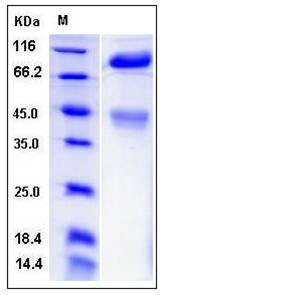Mouse c-MET / HGFR Protein (His Tag)
AI838057,c-Met,HGF,HGFR,Par4
- 100ug (NPP1541) Please inquiry
| Catalog Number | P50622-M08H |
|---|---|
| Organism Species | Mouse |
| Host | Human Cells |
| Synonyms | AI838057,c-Met,HGF,HGFR,Par4 |
| Molecular Weight | The recombinant mouse Met is a heterodimer composed of the proteolytically cleaved α and β subunits. The α and β heterodimer consists of 916 amino acids and has a predicted molecular mass of 102 (α =32 + β=70) kDa. The apparent molecular mass of the rmMET heterodimer thus is approximately 43 kDa and 85-95 kDa respectively in SDS-PAGE under reducing conditions due to glycosylation. |
| predicted N | Glu 25 & Ser 307 |
| SDS-PAGE |  |
| Purity | > 90 % as determined by SDS-PAGE |
| Protein Construction | A DNA sequence encoding the mouse MET (NP_032617.2) extracellular domain (Met 1-Asn 929) was fused with a polyhistidine tag at the C-terminus. |
| Bio-activity | Measured by its ability to compete with mouse C-MET for binding to immobilized human HGF in a functional ELISA assay. |
| Research Area | Cancer |Signal transduction |Protein Phosphorylation |Tyrosine Kinase |Receptor Tyrosine Kinases |
| Formulation | Lyophilized from sterile PBS, pH 7.4 1. Normally 5 % - 8 % trehalose, mannitol and 0.01% Tween80 are added as protectants before lyophilization. Specific concentrations are included in the hardcopy of COA. |
| Background | Hepatocyte growth factor receptor (HGFR), also known as c-Met or mesenchymal-epithelial transition factor (MET), is a receptor tyrosine kinase (RTK) that has been shown to be overexpressed and/or mutated in a variety of malignancies. HGFR protein is produced as a single-chain precursor, and HGF is the only known ligand. Normal HGF/HGFR signaling is essential for embryonic development, tissue repair or wound healing, whereas aberrantly active HGFR has been strongly implicated in tumorigenesis, particularly in the development of invasive and metastatic phenotypes. HGFR protein is a multifaceted regulator of growth, motility, and invasion, and is normally expressed by cells of epithelial origin. Preclinical studies suggest that targeting aberrant HGFR signaling could be an attractive therapy in cancer. |
| Reference |
